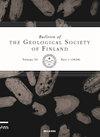波罗的海东南部库尔斯沙嘴沿线死(灰)沙丘演变的重建
IF 1.3
4区 地球科学
Q2 GEOLOGY
引用次数: 20
摘要
库尔斯沙嘴在环境和文化方面都是欧洲独特的地方之一,它是一个巨大的沙质屏障,将库尔斯泻湖与波罗的海分开。跨越立陶宛和俄罗斯的部分,吐痰被列入联合国教科文组织的文化遗产名录。从地质角度来看,它仍然是一个以风成沉积为主的“活”环境。在现代地球物理和地质年代学技术(探地雷达(GPR)调查、激光雷达数据和放射性碳[14C]测年)的帮助下,在库尔斯沙口立陶宛一半的Juodkrante和Pervalka定居点之间的死(灰)沙丘块上对古土壤进行了详细的调查。在5800-4500年、3900-3100年、2600-2400年和1900历年BP至今的几个土壤形成世代(阶段)已被区分出来。通过探地雷达调查,对该地块进行了一系列不同时间间隔的古地理重建。本文章由计算机程序翻译,如有差异,请以英文原文为准。
Reconstruction of the Dead (Grey) Dune evolution along the Curonian Spit, Southeastern Baltic
One of the unique places in Europe in both environmental and cultural terms is the Curonian Spit – a massive sandy barrier separating the Curonian Lagoon from the Baltic Sea. Straddling both the Lithuanian and the Russian parts, the spit is included into the UNESCO list of cultural heritage monuments. From the geological point of view, it is still an “alive” environment dominated by aeolian deposits. With the help of modern geophysical and geochronological techniques (ground-penetrating radar [GPR] surveys, LIDAR data, and radiocarbon [14C] dating), detailed investigations of paleosols were carried out in the Dead (Grey) Dunes massif located between Juodkrante and Pervalka settlements on the Lithuanian half of the Curonian Spit. Several soil-forming generations (phases) during 5800–4500, 3900–3100, 2600–2400, and from 1900 calendar years BP until the present have been distinguished. GPR surveys enabled a series of paleogeographic reconstructions of the massif for different time intervals of its evolutionary history.
求助全文
通过发布文献求助,成功后即可免费获取论文全文。
去求助
来源期刊
CiteScore
1.30
自引率
0.00%
发文量
5
审稿时长
>12 weeks
期刊介绍:
Bulletin of the Geological Society of Finland (BGSF) publishes research articles and short communications in all branches of geosciences. Contributions from outside Finland are welcome, provided that they contain material relevant to Finnish geology or are of general interest.

 求助内容:
求助内容: 应助结果提醒方式:
应助结果提醒方式:


